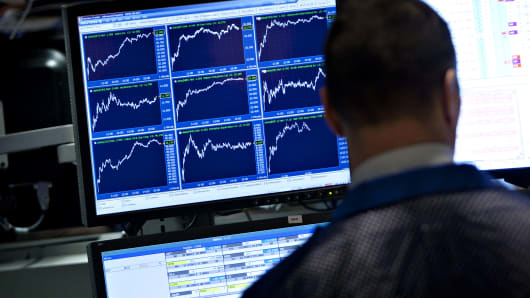While corporate bonds may not look terribly attractive
amid rising rate expectations, Goldman Sachs tips a good performance –
but only in the short term.
"The yield differential between U.S. and European bonds, coupled with the stronger dollar should drive demand for U.S. credit," Goldman said in a report dated Friday. "Return potential in U.S. high-yield credit is attractive as spreads have been volatile recently, in part due to lower oil prices, and should narrow again." Bond yields move inversely to prices.
Read More Why Europe's bonds keep finding buyers
It upgraded corporate credit to Overweight from Neutral on a three-month view, but is underweight on a 12-month outlook as it expects rising yields to weigh on returns.
Short term vs longer term
The Federal Reserve is widely expected to deliver its first interest rate hike sometime this year, in a step toward "normalizing" policy from the
zero-interest-rate policy (ZIRP) started at the end of 2008 during the Global Financial Crisis. Analysts expect that once the Fed moves, bond prices will fall.
"The yield differential between U.S. and European bonds, coupled with the stronger dollar should drive demand for U.S. credit," Goldman said in a report dated Friday. "Return potential in U.S. high-yield credit is attractive as spreads have been volatile recently, in part due to lower oil prices, and should narrow again." Bond yields move inversely to prices.
Read More Why Europe's bonds keep finding buyers
It upgraded corporate credit to Overweight from Neutral on a three-month view, but is underweight on a 12-month outlook as it expects rising yields to weigh on returns.
Short term vs longer term
The Federal Reserve is widely expected to deliver its first interest rate hike sometime this year, in a step toward "normalizing" policy from the
zero-interest-rate policy (ZIRP) started at the end of 2008 during the Global Financial Crisis. Analysts expect that once the Fed moves, bond prices will fall.
But in the short term, Goldman tips the higher-rated end
of the high-yield market and has a slightly overweight on U.S.
investment-grade credit over its European counterpart. Within Asia, it
prefers high-yield bonds over investment grade, but it's cautious on
China real estate offerings.
Despite concerns over rising rates, investors certainly appear to like bond funds, pouring around $95.31 billion into bond mutual funds and exchange-traded funds (ETFs) so far this year, with around $15.4 billion of that flowing into high-yield bond funds, according to data from Jefferies. That compares with around $150.6 billion that flowed into bond funds in 2014, according to EPFR Global data cited by Reuters.
Not optimistic
But fund managers aren't overly optimistic, with around 57 percent underweighting the segment, according to the Bank of America-Merrill Lynch fund manager survey for March. Additionally, the survey found going long on U.S. high-yield debt was considered the third-most crowded trade, after long European Union periphery debt and long U.S. dollar trades.
Read MoreHigh-yield debt market defies sceptics
Others don't expect much of a rally in bond prices, especially after the segment's gains ahead of the European Central Bank's (ECB) introduction of a quantitative easing program to buy government debt.
"Credit investors have extended longs significantly in anticipation of the PSPP (public sector purchase program) implementation, raising the possibility that the rally loses some momentum near term," Citigroup said in a note last week.
Despite concerns over rising rates, investors certainly appear to like bond funds, pouring around $95.31 billion into bond mutual funds and exchange-traded funds (ETFs) so far this year, with around $15.4 billion of that flowing into high-yield bond funds, according to data from Jefferies. That compares with around $150.6 billion that flowed into bond funds in 2014, according to EPFR Global data cited by Reuters.
Not optimistic
But fund managers aren't overly optimistic, with around 57 percent underweighting the segment, according to the Bank of America-Merrill Lynch fund manager survey for March. Additionally, the survey found going long on U.S. high-yield debt was considered the third-most crowded trade, after long European Union periphery debt and long U.S. dollar trades.
Read MoreHigh-yield debt market defies sceptics
Others don't expect much of a rally in bond prices, especially after the segment's gains ahead of the European Central Bank's (ECB) introduction of a quantitative easing program to buy government debt.
"Credit investors have extended longs significantly in anticipation of the PSPP (public sector purchase program) implementation, raising the possibility that the rally loses some momentum near term," Citigroup said in a note last week.
"The signs are encouraging that if a Fed hike were to have negative ramifications for the credit markets, it would be more of a hiccup than a tantrum," Citigroup said. "Yet on the flip side, that doesn't mean that U.S. investment-grade spreads rally into a hike either, it's far more likely in our opinion that spreads continue to trade within the 10-15 basis-point range they've occupied for the last few months."


No comments:
Post a Comment